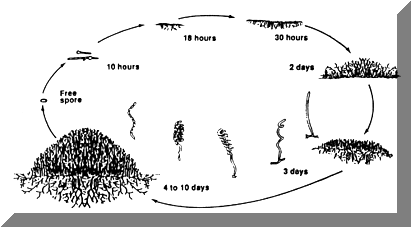Be aware!
I love complex life cycle!
Streptomyces platensis have a complex-life cycle that is characterized by three phase: spores, vegetative mycelium, and aerial mycelium.
First there is production of a free spore which can give rise to, at least, one multi-nucleid filament divided by semi permeable cross walls: septa. This step is called germination and occurs when the free spore end up on an adapted habitat, nutritious soil (cf. nutrition).
Once we have our filaments, there is a vegetative growth which is characterized by the formation of the vegetative mycelium by elongation of the filaments. The bacterium will need a stimulus from the environment to start the formation the aerial mycelium. It is in between the two stages that there are formation of the numerous secondary metabolites that many pages from this website refer to, especially the interesting facts page. You do not want to miss that!
After signals, the bacterium breaks up the surface barrier to let it form the aerial mycelium upon deletion of nutrient. It is the stage where the formation of spores occur. In fact, at the tips of the aerial mycelium, septation occurs by making the septa more permeable to form exospores. That is the sporulation of the bacterium which helps the development of the colony.
There is more than a life cycle to understand this bacterium. In fact, the sporulation is not the only link among the different bacteria of the colony. There is an exchange of genetic information among them for a better adaptation and evolution. So do not wait, and jump to the adaptation of Streptomyces platensis.
